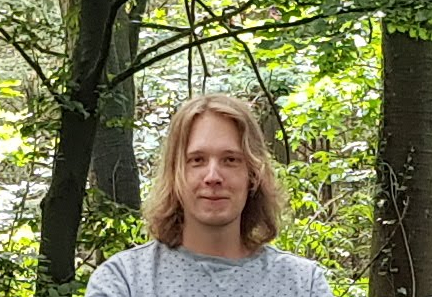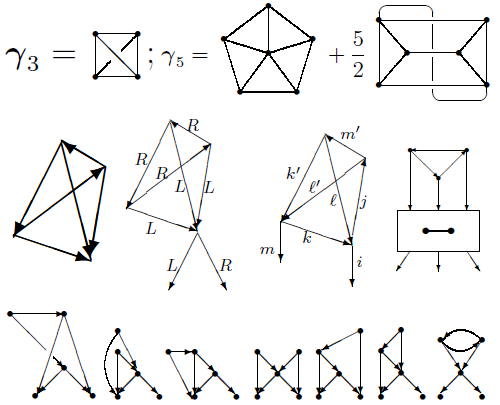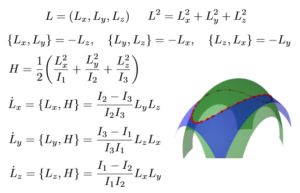10 out of 200: From diagrams to formulas via computers – Ricardo Buring loves teaching math
Jens-Steffen Scherer
Meet Ricardo Buring, mathematician and one of this year’s 10 out of 200 young researchers participating in the 7th Heidelberg Laureate Forum from September 22nd – 27th, 2019.

What are your name and nationality?
My name is Ricardo Buring and I’m Dutch.
Where did you study and where are you currently based?
I started studying mathematics at the University of Groningen in the Netherlands and got my bachelor’s and master’s degrees there. Now I’m living and working in Mainz, Germany.
What is your current position?
I’m a math Ph.D. student at Johannes Gutenberg-Universität Mainz.
What is the focus of your research? What is your research project?
I study the action of graph complexes on Poisson structures. On the one hand graphs (diagrams consisting of dots and lines) are discrete combinatorial objects (fig. 1).

On the other hand, a Poisson structure is a geometric object. It is defined on a manifold, whose points we interpret as states (e.g. of a physical system). Namely, a Poisson structure sends any number-valued function on the manifold to a vector field on that manifold. (A vector field is an assignment of a tangent vector/direction to every state.) The Poisson structure interprets the input function as the energy, and (by the vector field pointing in a direction) it gives the corresponding laws of motion on the manifold. (Consequently, it also dictates the time-evolution of the value of any number-valued function on the manifold.) For example, the motion of a spinning top can be described as a Poisson system, by considering the angular momentum (pseudo)vector \(L\) as a state in a natural coordinate system fixed to the body (fig. 2).

Here the green ellipsoid is a surface consisting of states with a given constant energy, and the blue sphere is a surface of constant (squared) magnitude. One can verify that the energy and (squared) magnitude are always constant in time (i.e. \(\frac{dH}{dt} = \{H,H\} = 0\) and \(\frac{dL^2}{dt} = \{L^2, H\} = 0\)), so the motion of any state must take place in the intersection of such level-surfaces. The exact motion of the endpoint of a vector \(L\) (drawn in red) is given by the time-evolution of its coordinates, in terms of the Poisson bracket with \(H\).
More generally, a Poisson structure is given in local coordinates on the manifold by an antisymmetric matrix of functions governed by the Jacobi partial differential equations. As above, it provides a mapping from energy to dynamics.
At first glance, Poisson structures and graphs live in totally different worlds, and they seem to have nothing to do with each other. The link between them (due to Kontsevich, who was inspired by Feynman diagrams from physics) is that one can build formulas – depending on a Poisson structure – out of graphs: vertices (containing functions) represent factors in a product, outgoing edges represent upper indices, incoming edges represent derivatives, and we sum over repeated indices (fig. 3).

This turns out to be a powerful idea. By force of our will, we can introduce relations on the space of sums of graphs which would hold on the level of formulas for every Poisson structure. Consequently, proving an identity on the level of graphs will prove it for all Poisson structures at the same time.
The main reason this graph formalism was invented – by Maxim Kontsevich, who received the Fields Medal in 1998 for this work among other things – is that these graphs can be used to solve the problem of formal deformation quantization on affine Poisson manifolds. This entails deforming the ordinary pointwise product of number-valued functions into a “quantum product” which is still associative but generally noncommutative: the commutator is a deformation of the Poisson bracket. Secondly, non-oriented graph cocycles yield “universal” deformations of Poisson structures (or symmetries of the Jacobi identity); their nature is still a mystery at the time of this answer. The underlying reason for these two theorems is the existence of certain \(L_\infty\)-morphisms, also due to Kontsevich. While much has been written about all this, parts of these theorems were not written very explicitly in the literature. My supervisor Arthemy Kiselev and I have been remedying this, presenting the results (with proofs) in an explicit and accessible way, and giving very concrete examples which were not available before. During my master’s thesis, I also started to implement the graph calculus in software, and I am still improving and extending that package. This enabled us to do some big calculations involving millions of graphs, has allowed for easy checking of results in the literature (which also revealed some errors), and yielded new results like an expression for the star-product up to order 4.
Why did you become a mathematician?
My interest in math came as a result of trying to solve the Project Euler programming problems in high school. These are problems that can be solved by writing an appropriate computer program. The catch was that the “naive” solution was always a suboptimal one; making use of mathematical insights would yield much more efficient solutions. This fascinated me and led me into the rabbit hole of mathematics. I still particularly enjoy constructive proofs and explicit algorithms. In my view, it is very beneficial and fun to be able to play with mathematical objects on a computer. In some sense, these objects really exist, in their own world inside the computer, which becomes a playground for the mathematician.
What are some of the fundamental challenges you have faced in your academic career?
I had a slightly rocky start. In high school, I had barely passing grades in math, and I had to retake the final math exam. In retrospect, my approach to studying was wrong. I was tricking myself into believing that I understood, by just reading and not doing, by following solution manuals instead of thinking for myself. Now I strongly believe that after reading or listening to a lecture, you must do the math yourself (and fail, identify your mistakes and gaps in your knowledge, and get help to fix them) and there is no way around that. By contrast, learning programming was almost all learning by doing, so I could have realized this earlier. After high school, I studied computer science at the Hanzehogeschool Groningen for one year, during which I also took an extra math course. At the end of the first year, I applied to the University of Groningen to study math. I had to take an entrance exam, which I failed the first time. Finally, I passed – with many thanks to the course I took at the Hanze – and I was accepted. My grades in the first semester were not great, largely due to leftovers of my high school mentality, which had evolved into “calculations are beneath me, I want to do proofs” (I now find this to be a special kind of stupid). Proofs are fantastic of course, but also algorithms are everywhere (even inside proofs), and the value of doing computations (to get a feeling of what you are working with, and to illustrate general results) cannot be overstated. Eventually, I adjusted and my grades improved. For my Ph.D. I moved to Germany and it was a challenge to pick up the German language, but I’m doing alright (supertoll) now.
What do you feel are the greatest pressures facing scientists today?
The greatest tragedy of our lifetime is the extinction of blackboards. More seriously, I feel that there is much pressure to publish when the alternative is to perish. Also, in my limited experience, the amount of funding available for pure math research seems to be small. I understand that it will likely stay small in a relative sense (say, compared to funding for medical research) but I hope that it will increase in an absolute sense, as the number of math Ph.D. students is also increasing.
More tangentially, I have found many math papers (both old and new) containing very few examples or even no examples whatsoever. In my opinion, this puts pressure on the reader to provide his own examples, who may not even be able to do so. Examples clarify general theorems a great deal, and I feel they should not be withheld.
What are you doing besides research?
The past few semesters I’ve taught exercise classes in discrete math and computer algebra, which I enjoyed a lot. My approach is to make a list of all possible mistakes which are revealed by correcting the homework and to discuss all of them in the tutorial, because you can learn a lot from your mistakes and the mistakes of others. I also tutor students in these subjects and a few more. Besides this, I enjoy answering questions online, on the Math StackExchange, MathOverflow, and on Ask SageMath (where I’ve answered 139 questions about the computer algebra system SageMath). This also helps to keep me sharp. It is said that teaching a subject is the best way to learn it, and this is a mini version of that. My two main hobbies are video game design and development and skateboarding. My side gig is software development, mainly web applications (the latest was a mobile web app for employees to record the hours that they worked). For leisure, I enjoy reading books (currently East of Eden by John Steinbeck), listening to music (mainly indie rock, e.g. Modest Mouse), going to the movies and watching many television series (The Sopranos is the best of all time).
How did you hear about the HLF and why did you apply?
It came highly recommended by my friend Tamás Görbe, who attended the 6th HLF. I applied because I didn’t want to miss the opportunity to attend this event, even if it seemed like a long shot to me. I was delighted to hear that I had been selected.
What do you expect from this meeting?
I expect to meet interesting people. All the young researchers having applied for the HLF means we’ll have some ambition in common. I look forward to hearing about everyone’s work and their hobbies. As for the talks, it is always a pleasure to hear experts talk about their specialties.
Which laureates present at the forum would you really like to talk to and what do you want to ask them?
I would like to talk with Leslie Lamport, who has interesting ideas about how proofs should be written. I’d also like to ask Gregory Margulis about his work on affine manifolds and Efim Zelmanov about his work on Lie algebras. Maybe most of all (talking-wise) I look forward to listening to everyone’s stories and anecdotes. It will also be great to meet some of the people whose work I encountered during my undergraduate studies (which shows how fundamental their work is), such as the pair behind the Diffie-Hellman key exchange, Dana Scott who (jointly with Michael O. Rabin) introduced the nondeterministic finite automaton, and Stephen Smale who introduced the horseshoe map (I co-wrote a report about it in the first year of my bachelor’s).
Who were your most important mentors and what lessons did they pass on to you?
My most important mentors were my thesis advisors, who also taught some of my favorite courses. Arthemy Kiselev – my master’s thesis advisor and currently my Ph.D. thesis advisor – has taught me a lot about how to do research, how to approach mathematical problems, and about writing. The teaching style of Jaap Top – my bachelor’s thesis advisor – also had a big influence on me.
What are your preferred formats to communicate your research to others and why?
I like to write articles with extensive examples, including sample code which the reader can run, preferably in some free software. I think this can help the reader a lot with understanding (it certainly helps me) and it makes the whole a lot livelier. I also like giving talks, preferably on a blackboard but possibly with some supporting slides showing pictures which would take a long time to draw live.
Der Beitrag 10 out of 200: From diagrams to formulas via computers – Ricardo Buring loves teaching math erschien zuerst auf Heidelberg Laureate Forum.